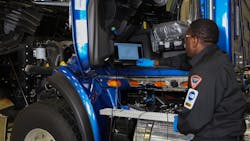In the commercial vehicle industry’s ongoing challenge of finding and retaining qualified technicians, employers, OEMs, fleets, and technical schools all play an important role in ensuring engagement. Everyone in the industry must work together to create continued visibility and education of the trades, foster partnerships between service providers and educators, and appeal to more young, technically minded individuals. This helps to establish a pipeline of technicians who are passionate about starting and maintaining a solid career in the commercial vehicle industry.
Creating a pipeline
Finding and recruiting technicians is a national issue with a local solution. A major focus of combating the technician shortage means providing dealers responsible for servicing commercial vehicles the tools and knowledge to develop relationships at a local level with high schools and technical schools. When service providers work directly with educators to develop these programs, it establishes a pipeline of future employees who have the proper training in the fields they are being hired for. While new hires do not yet have the necessary industry experience, programs like this provide proper training that helps with their professional development.
See also: Why are shops still a 'no woman’s land'?
It’s critical to communicate with dealers to understand their needs and be able to provide supportive resources, including creating local connections to a direct source of technicians. When service providers and educators communicate and work together, both can benefit. Service providers share training needs and resources that can be utilized to educate students, and educators benefit by creating local connections to establish job placement and mentorships after graduation from technician programs.
To put down a foundation for a pipeline, Navistar worked to develop a program that works closely with educators, called the TECH EmPOWERment program. Created in 2020, this program provides service managers throughout the dealer network with solutions and tools to build a solid culture to attract, engage, retain, and empower technicians.
The program provides an opportunity for the dealer network to partner with accredited trade schools for equipment donations and recruiting. Dealers also donate vehicle equipment and tools to these partner trade schools, which are used to train incoming technicians. It is essential technicians have experience servicing vehicles with current and upcoming technologies rather than the same hands-on tools schools may have been using for decades.
Connecting employees
The industry must change the perception of a technician being looked at as a so-called “grease-monkey” or “mechanic.” A technician career in today’s industry requires knowledge in cutting-edge technology and diagnostics. This starts and ends with ensuring technicians are knowledgeable in their skillsets and have the option to explore more technologies in-depth.
Just like any good relationship, communication and transparency are required. Providing transparency on company operations, culture, and benefits from the time of hire throughout a technician’s career has exponential value. Having a comprehensive onboarding and training process to ensure technicians feel comfortable and connected to their peers and managers also creates a culture of trust.
Education is important for all, not just rookies. Fostering the development of existing employees through open communication from management and regular training to continue to advance skills showcases the critical need to learn and stay on top of the quickly changing technologies in the industry.
See also: Women in Navistar’s service network help drive female technician recruitment
Younger generations are becoming less fond of accumulating debt to attend traditional four-year schools and want a more direct path toward a career where they can earn a living while learning the skills they need. This provides the perfect opportunity for apprenticeship programs.
With an apprenticeship, technicians have a chance to experience hands-on learning with experienced peers. They get to see the day-to-day operations of a dealership from the inside and feel the experience firsthand rather than hearing about it from a professor. On top of training with traditional diesel vehicles, apprentice technicians should get the opportunity to work on the latest innovations across the industry, like electric vehicles.
Looking ahead
Technicians will continue to be at the front and center of keeping the transportation industry running, and it falls to those closely involved in every level of recruitment and retention to provide them with the tools they need to be successful.
Continued industry partnerships between service providers and educators will be key. That’s done through fostering relationships and providing the necessary tools and equipment to facilitate and learn proper service processes. It will be critical to reach the younger generation entering the workforce who are native technology users, through gamification and in-bay tools such as virtual reality and augmented reality, to encourage interest in the industry.
Ana Salcido is the Technician Recruitment Manager for Navistar, supporting technician recruitment, hiring, and retention for the International and IC Bus dealer networks. Salcido joined Navistar in 2012, performing various roles in the company’s Aftersales organization, the Service Products Support Team, the Employee Resource Groups, and served as the Graphic Development Manager. Salcido earned her Bachelor of Arts in International Business from the Instituto Tecnológico y de Estudios Superiores in Monterrey, Mexico.
About the Author

Ana Salcido
Ana Salcido is the Technician Recruitment Manager for Navistar, supporting technician recruitment, hiring and retention for the International and IC Bus dealer networks.
Salcido joined Navistar in 2012, performing various roles in the company’s Aftersales organization. She started as a Project Manager for the Global Region, then managed the Service Products Support Team for four years working with dealers, fleets and customers to provide support in areas such as diagnostic and programming software, electronic service tools and hard line tools. From there, she worked for three years as the Graphic Development Manager providing digital illustrations, 3D modeling and graphic design collateral used in training courses, technical publications, operations manuals, marketing deliverables and special events. During her time at Navistar, Salcido has been very involved with the Employee Resource Groups working and collaborating with her colleagues.
Salcido earned her Bachelor of Arts in International Business from the Instituto Tecnológico y de Estudios Superiores in Monterrey, Mexico. She is bilingual, speaking both Spanish and English.
When she’s not working, Salcido enjoys traveling and exploring new places, planning road trips, biking, going to parks and spending time with her family.
